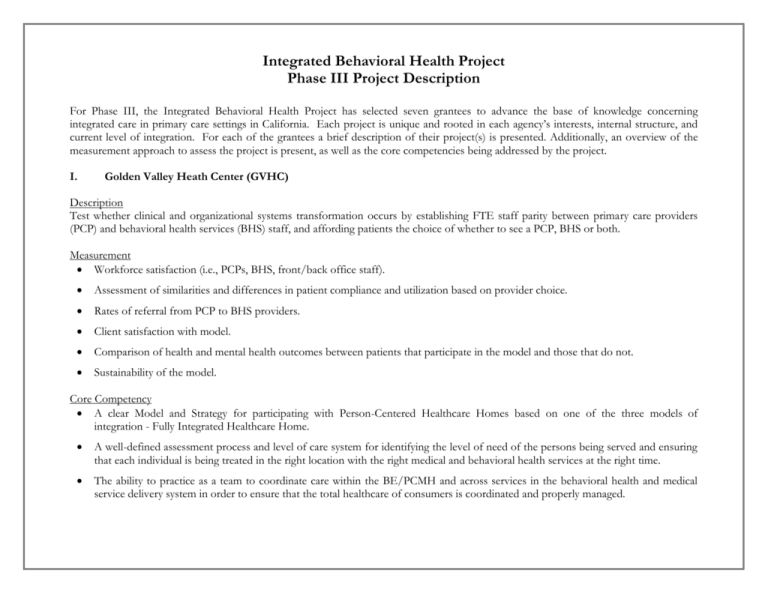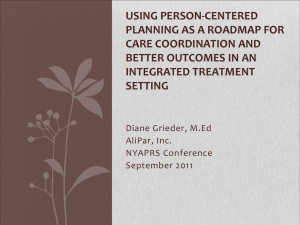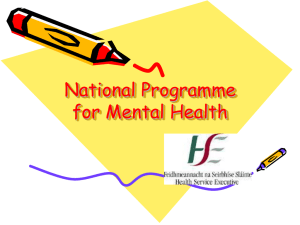Integrated Behavioral Health Project
advertisement

Integrated Behavioral Health Project Phase III Project Description For Phase III, the Integrated Behavioral Health Project has selected seven grantees to advance the base of knowledge concerning integrated care in primary care settings in California. Each project is unique and rooted in each agency’s interests, internal structure, and current level of integration. For each of the grantees a brief description of their project(s) is presented. Additionally, an overview of the measurement approach to assess the project is present, as well as the core competencies being addressed by the project. I. Golden Valley Heath Center (GVHC) Description Test whether clinical and organizational systems transformation occurs by establishing FTE staff parity between primary care providers (PCP) and behavioral health services (BHS) staff, and affording patients the choice of whether to see a PCP, BHS or both. Measurement Workforce satisfaction (i.e., PCPs, BHS, front/back office staff). Assessment of similarities and differences in patient compliance and utilization based on provider choice. Rates of referral from PCP to BHS providers. Client satisfaction with model. Comparison of health and mental health outcomes between patients that participate in the model and those that do not. Sustainability of the model. Core Competency A clear Model and Strategy for participating with Person-Centered Healthcare Homes based on one of the three models of integration - Fully Integrated Healthcare Home. A well-defined assessment process and level of care system for identifying the level of need of the persons being served and ensuring that each individual is being treated in the right location with the right medical and behavioral health services at the right time. The ability to practice as a team to coordinate care within the BE/PCMH and across services in the behavioral health and medical service delivery system in order to ensure that the total healthcare of consumers is coordinated and properly managed. II. Hill County Community Clinic (HCCC) Description Assessment of satisfaction levels by providers, other delivery team and office staff, and patients engaged in the HCCC Behaviorally Enhanced/Primary Care Medical Home (BE/PCMH) model that includes a psychiatric nurse practitioner Measurement Comparison of satisfaction levels between patients receiving primary care and patients receiving integrated care. Comparison of satisfaction among non-provider team members at beginning and at end of grant period. Comparison of satisfaction among provider team members at beginning and at end of grant period. Core Competency The ability to practice as a Team to Coordinate Care within the BE/PCMH and across services in the behavioral health and medical service delivery system in order to ensure that the total health care of consumers is coordinated and properly managed. Description Demonstrate how i2i Tracks can be used to enhance integrated care for patients within a BE/PCMH, including tracking of case management services for the SMI population. Measurement Develop comprehensive data dictionary of variables tracked in i2i Tracks. Baseline comparisons of patient functioning using clinical and behavioral health metrics. Core Competency A robust Electronic Health Record that includes Patient Registry functionality and the ability to electronically share medical records with other provider organizations and receive that information for the consumers served by the CBHO. III. Lifelong Medical Care (LMC) Description Explore the role of clinical care assistants as a bridge between mental health and primary care for patients with diabetes at West Berkeley Family Practice. Measurement Description of BH/PCMH model and the clinical care assistant’s role and responsibilities. Reports on use of diabetic face sheet by BHS staff to enhance their involvement in supporting clients’ self-management goals and in communicating with PCPs. Patient satisfaction with diabetes care, including integration of physical and behavioral health care services. Core Competency The ability to practice as a Team to Coordinate Care within the BE/PCMH and across services in the behavioral health and medical service delivery system in order to ensure that the total health care of consumers is coordinated and properly managed. Description Maximize use of i2i Tracks in monitoring integrated care for patients with diabetes. Measurement Develop comprehensive data dictionary of variables tracked in i2i Tracks for patients with diabetes, including self-management goal and no-shows appointments. Workforce satisfaction survey completed by PCPs, BHS staff, and front/back office staff. Primary care and behavioral health metrics associated with medical and mental health outcomes. Core Competency Measurement Systems and Tools that measure improvements in each consumer’s behavioral health status and processes that use those data on a timely basis to adjust care as needed. Description Identify the programmatic elements (i.e., psychosocial staff knowledge about diabetes) that enhance the BE/PCMH model and contribute to its comprehensiveness. Measurement Description of BE/PCMH model with key elements delineated. Pre- and post-test change in psychosocial staff diabetes knowledge. Chart reviews of patients with diabetes receiving primary care and behavioral health services to assess levels and means of integration and coordination of care. Core Competency Quality improvement processes and supporting data systems that allow organizations to run continuous experiments in improvements at every level of the organization in order to increase the effectiveness and efficiency of services and the infrastructure that supports service delivery. IV. San Diego Council of Community Clinics (SDCCC) Description Examine the differences in primary care indicators (i.e., blood pressure, cholesterol, body mass index, weight, and HA1c) for 250 public agency mental health clients that are linked to a paired BH/PCMH, a community-based primary care provider, or that are not linked to primary care. Measurement Patient referral confirmations for each of the two primary care service forms and for those that do not accept a referral and do not have a primary care provider. Comparison of clinical measures. Core Competency A clear Model and Strategy for participating with Person-Centered Healthcare Homes based on one of the three models of integration - Fully Integrated Healthcare Home. Description Examination of differences in perception and receipt of supportive services from NOMS (National Outcome Measures) for 250 public agency mental health clients that are linked to a paired BH/PCMH, a community-based primary care provider, or that are not linked to primary care. Measurement Perception of care, functioning in everyday life, education and employment, stability in housing, etc. Core Competency A clear Model and Strategy for participating with Person-Centered Healthcare Homes based on one of the three models of integration - Fully Integrated Healthcare Home. Description Examination of differences in emergency room utilization and hospitalizations for 250 public agency mental health clients that are linked to a paired BH/PCMH, a community-based primary care provider, or that are not linked to primary care. Measurement Patient self-reports on ER utilization and hospitalizations differentiated by PCP referrals and non-referrals. Core Competency A clear Model and Strategy for participating with Person-Centered Healthcare Homes based on one of the three models of integration - Fully Integrated Healthcare Home. Description Examination of differences in participation in wellness programs by site, type of offering, and descriptive and diagnostic data for 250 public agency mental health clients that are linked to a paired BH/PCMH, a community-based primary care provider, or that are not linked to primary care. Measurement Wellness program attendance data. Core Competency A clear Model and Strategy for participating with Person-Centered Healthcare Homes based on one of the three models of integration - Fully Integrated Healthcare Home. Description Compare and contrast provider satisfaction with services within each of the two distinct behavioral health/physical health agency pairings. Measurement Random checks of patient charts for combined medical and mental heath information. Satisfaction survey completed by BHS staff (i.e., psychiatrists, care coordinators and other mental heath staff), and PCPs and other medical staff. Core Competency The ability to practice as a Team to Coordinate Care within the BE/PCMH and across services in the behavioral health and medical service delivery system in order to ensure that the total health care of consumers is coordinated and properly managed. V. Sierra Family Medical Clinic (SFMC) Description Assess integrative process and patient outcomes associated with the co-location of an independent substance abuse agency (Common Goal) within a primary care setting (SFMC). Measurement Bi-directional utilization of the warm handoff between agencies. Comparison of clinical outcomes (MAST, BECK, ASI, and SASSI) for 40 substance abuse treatment clients seen by SFMC and Common Goal receiving primary care and behavioral health services, in addition to substance abuse treatment, and 40 substance abuse treatment patients only seen by Common Goal. Workforce satisfaction for PCPs, BHS staff, front/back office staff, substance abuse counselors and agency managers. Length and duration of visits for treatment and comparison group. Percentage of bi-directional referrals made and completed between primary care and substance abuse programs. Patient no-show rates. Core Competency A clear Model and Strategy for participating with Person-Centered Healthcare Homes based on one of the three models of integration - Fully Integrated Healthcare Home. St. John’s Well Child and Family Center (SJWCFC) Description Design and implement a system for identifying persons with behavioral health problems, determining level of patient need, and monitoring of progress. Measurement Systems development outcomes (i.e., selection of universal screening tool, protocols on administration, determining threshold scores, clear pathways for treatment, and tracking mechanism). Percentages of patients screened, patients referred, elapsed time between identification and treatment, patients that attain progress measures). Satisfaction with IBHP technical assistance. Core Competency A well-defined assessment process and level of care system for identifying the level of need of the persons being served and ensuring that each individual is being treated in the right location with the right medical and behavioral health services at the right time. Description Establish a team approach toward developing a behavioral health treatment plan and maintaining ongoing joint responsibility for patient care. Measurement Written policies and procedures Satisfaction with technical assistance provide by IBHP. Log of care counseling sessions and informal consultations among team members. Log of interdisciplinary training. Patient satisfaction in accessing team members. Provide satisfaction with team approach. Review of patient charts for team member entries. Core Competency The ability to practice as a Team to Coordinate Care within the BE/PCMH and across services in the behavioral health and medical service delivery system in order to ensure that the total health care of consumers is coordinated and properly managed. Description Transition to i2i Tracks and implement a behavioral health module to track status of patients receiving behavioral health services and treatment. Measurement Variable template for i2i and reports. Staff satisfaction and reported use of information. Core Competency Measurement Systems and Tools that measure improvements in each consumer’s behavioral health status and processes that use those data on a timely basis to adjust care as needed. Phase III Grantee Measurement Comparison Data Collected GVHC HCCC LMC SDCCC SFMC SJWCFC Workforce Satisfaction X X X X X X Patient Compliance X X X Service Utilization (e.g., frequency and duration) X X X Bidirectional Referrals X X X Patient Satisfaction X X X Health / Mental Health Outcomes X X X Systems / Model Evaluation X Data Dictionary for i2i Tracks X X X X X BHS/PCP Patient Progress Reports X X X X IBHP TA Satisfaction QuasiExperimental Design X X X X X X Phase III Grantee Core Competency Comparison (see next page for legend) Core Competency GVHC 1 X HCCC LMC SDCCC SFMC X X SJWCFC 2 3 X X X X X X X 4 5 X X X X 6 7 8 9 10 X X X Ten Elements for a Behaviorally-Enhanced Person-Centered Healthcare Home 1 A clear Model and Strategy for participating with Person-Centered Healthcare Homes based on one of the three models of integration - Fully Integrated Healthcare Home, Focused Partnership Healthcare Home, or Linkages with multiple Medical Homes 2 A full Array of Specialty Behavioral Health Services provided inside the organization and/or through contract with specialty behavioral health partners 3 A well defined Assessment Process and Level of Care System for identifying the level of need of the persons being served and ensuring that each individual is being treated in the right location with the right medical and behavioral health services at the right time 4 A solid approach to Prevention, Early Intervention, and Recovery that includes critical components of managing the total healthcare expenditures for persons with serious mental health and substance use disorders 5 The ability to practice as a Team to Coordinate Care within the BE/PCHH and across services in the behavioral health and medical service delivery system in order to ensure that the total health care of consumers is coordinated and properly managed 6 Demonstrated use of Clinical Guidelines that are embedded in the fabric of each clinician and case manager’s practice in order to ensure that effective treatment is occurring based on the clinical needs of each consumer 7 Measurement Systems and Tools that measure improvement in each consumer’s behavioral health status and processes that use those data on a timely basis to adjust care as needed 8 A robust Electronic Health Record that includes Patient Registry functionality and the ability to electronically share medical records with other provider organizations and receive that information for the consumers served by the CBHO 9 Quality Improvement Processes and supporting Data Systems that allow organizations to run continuous experiments in improvement at every level of the organization in order to increase the effectiveness and efficiency of services and the infrastructure that supports service delivery 10 Financial Systems that have the ability to manage Case Rate Payments, the FQBHC Prospective Payment System, and the ability to track the total healthcare expenditures down to the individual level provided inside the organization







